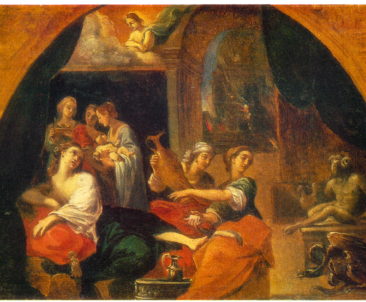

Annibale Carracci is one of many brilliant names in the history of Italian painting. Born in 1560 in Bologna in the family of an artisan, young Carracci realized that handicraft would not satisfy his ambition, and, following Agostino’s elder brother and Ludovico’s cousin, the future artist decided to devote his life to art. The early years of Annibale’s apprenticeship are hidden by a veil of secrecy, but it is commonly believed that the emergence of Karacchi’s style took place under the influence of a popular trend in this period – late Mannerism.
Despite this, already in the early works of Annibale fully manifested the originality of his technique. Features of work with color have caused a stream of criticism from the adherents of the classical old school. But the young artist did not stop the attacks of society, and later his style continued to develop. Already in 1582 the brothers Carracci earned praise for their craftsmanship – the order for the painting of the Fava Palace in Bologna. Researchers agree that this work is a model of an amazing style unity. The painting of the three halls, representing scenes from ancient mythology, took the brothers about two years. The result of Carracci’s new work was no longer the criticism, but the envy of the less fortunate colleagues.
In 1585, Annibale and Agostino Carracci founded their own school, later named “Academy of Desiring”. Annibale took an active part in the pedagogical and artistic activities of the Academy.
In 1597, Annibale Carracci was invited to Rome by Cardinal Farnese to design the Palazzo Farnese with a fresco painting on mythological subjects. This work was taken from Annibale and his brother Agostino along with the disciples for eight years. The frescoes they created were named “Triumph of Bacchus and Ariadne”, “Mercury and Paris”, “Pan and Diana”, “Jupiter and Juno”, etc., remarkable for their successful distribution, in terms of meaning and variety of composition and fresh colors belong to a number of especially successful works of the artist.
In 1602, Annibale Carracci received an order for the decoration of the Roman chapel of Herrera de San Giacomo degli Spagnoli. However, since the beginning of 1605, severe rheumatic pains deprived the artist of the opportunity to paint.
Despite general recognition, Annibale Carracci died at the age of 49 in poverty and was buried in accordance with his death request in the Pantheon, next to Rafael Santi, the great Italian painter.